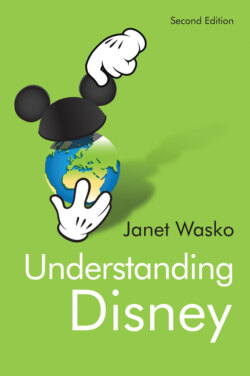Читать книгу Understanding Disney - Janet Wasko - Страница 10
Studying Disney
ОглавлениеStudying Disney can be challenging in many ways. When it is introduced as a topic for discussion, Disney is most often accepted with unqualified approval, and even reverence, by the American public, as well as by many international audience members. Many feel that the Disney company is somehow unique and different from other corporations, and its products are seen as innocent and pleasurable. There is a general sense that its products are only entertainment, as Walt Disney constantly reminded everyone. It is as though the company and its leaders can do no wrong – after all, they’re making so many people so happy. And they do it so well – how can one not be awed by their success?
There is also some hesitancy to discuss Disney as a business, despite the overwhelming emphasis on stockholder value and corporate goals by the company itself. In some settings, calling Walt Disney a “capitalist” would be considered risky, despite his role as head of a profit-motivated company. Furthermore, taking a critical stance towards the company that has created the happiest places on earth may be considered overly pessimistic, not to say downright un-American. After all, why should it be taken so seriously? As we’re told continuously, it’s just entertainment.
Nevertheless, it is important to consider the Disney phenomenon seriously and to insist that it is a legitimate focal point for cultural and social analysis. It is appropriate not only to look more closely at the Disney company and its products but also to critique their role in our culture. Indeed, with the proliferation of Disney products and the diversification of corporate activities, one must insist that Disney is fair game for serious critical review.
This is not to say that the Disney phenomenon has gone unnoticed. Indeed, the attention that Walt Disney, the Disney company, and Disney products have received in print is staggering. Several books consist mainly of references to Disney material,3 while a search on Amazon’s website in September 2018 resulted in more than 50,000 books listed with “Disney” in the title. (Of course, many of these are Disney products.) To this must be added the constant attention that the company and its products receive in the popular press, which has contributed to the Disney phenomenon.
In some academic circles, the study of Disney in particular, and popular culture in general, has been perceived as an irrelevant, frivolous, “Mickey Mouse” occupation. Nevertheless, Disney has been the focus of study in a wide variety of disciplines, with countless books, essays, and articles on Walt Disney, his contribution to animation, the history of the Disney company, and the analysis of its products and their creators.
In the 1930s, cultural pundits and film critics celebrated Disney as art, while members of the Frankfurt School often used Disney characters such as Mickey Mouse and Donald Duck as examples in their discussions of the culture industry. In addition to Michael Real’s study, the Disney empire attracted the attention of communications scholars in several classic studies in the 1970s, specifically Ariel Dorfman and Armand Mattelart’s How to Read Donald Duck and Herbert Schiller’s The Mind Managers.4
However, in the 1990s, there was a boom in “Disney studies” that attracted the attention of the popular press and others, not always in a favorable way. Numerous scholars continue to direct attention to the phenomenon and have joined in “the fashionable sport of Disney bashing.” Analysis has featured rhetorical, literary, feminist, and psychoanalytic critiques, stressing social issues, such as race and gender representation. Anthropologists, architects, historians, and geographers are still seriously discussing the impact of Disney’s worlds (especially the theme parks), considering their aesthetic, cultural, and social implications.
